The modern workplace is very different than what it used to be. The concept of showing up, performing tasks, and receiving a paycheck doesn’t hold the same weight. Now that Gen Z has entered the workplace, today’s employees are increasingly seeking roles in organizations that not only recognize their contributions but also support their well-being and professional growth.
Recent findings from Gallup’s State of the Global Workplace report shed light on this shift, revealing that while employee engagement is improving, over half (51%) of the workforce is still on the lookout for new opportunities, signaling a critical need for companies to reevaluate how they engage with their employees.
This underscores the importance of focusing on employee experience, a holistic approach to fostering a work environment that nurtures each individual’s journey within the company. By prioritizing the employee experience, organizations can unlock the potential for enhanced productivity, better retention rates, and, ultimately, superior business outcomes.
What is the employee experience?
Employee experience is everything that your workers will be exposed to when in contact with your company. From the moment they first see your job ads to their exit survey, every little thing they interact with will inform their personal employee experience.
No two employees will have the same career. Even if they are hired to perform identical roles, their individuality will cause them to approach tasks differently and deliver results in ways unique to them. In larger workforces, they might build relationships with different colleagues, and could even end up on a different path than the other.
This is why employee experience needs to be flexible enough to create something personalized for each and every worker. Whether they are on a temporary contract or a permanent one, whether they are in the C-suite or just an intern in their first corporate job, employees should be allowed to shape their own experience within a company.
Creating a positive employee experience strategy is no mean feat, but it can deliver great results when properly nurtured. Employees will always be the heart of a company, so the least the business can do is ensure that they have a supportive and positive place to work.
Employee Experience vs Employee Engagement
Employee experience and employee engagement sound interchangeable. While there are some crossovers, they are distinctly different.
Typically, we speak about employee engagement when we look at how a worker is committed to the job and how productive they are. Engaged employees easily complete their tasks and feel fulfilled by their workload and the expectations of the company.
While this is indeed part of the employee experience, it is just one fraction of the whole discipline. Compared to employee engagement, employee experience is a much more holistic element.
When trying to fix a poor employee engagement rate, management might look to introduce a new tool, such as employee experience software, to boost internal communications. Or they might decide to offer new perks, such as free snacks or discounted gym memberships. These can be great for addressing employee engagement issues in the short term, but they can also be stepping stones en route to a greater and more holistic employee experience framework.
Employee experience should always be a people-centric process.
Think about it: customer satisfaction is rooted in the needs, expectations, and fears of the customer. Businesses need to embrace similar thinking when it comes to their employees. We would not expect a customer who had a poor experience with a company to return for more service, so why should we expect a poorly treated employee to do the same?
What are the components of a positive employee experience?
By keeping a people-centric focus on creating an employee experience framework, business and HR leaders should be able to break down the over-arching experience into three targets. By investing and developing the physical, digital, and cultural experience of employees, a workplace can begin to create the company culture that both they and their workers wish to see.
Physical experience
The physical experience of a work environment is usually tied to our physical senses. We all need a clear and functional area to work from, whether we go to an office or we work from home. This can start with a desk, natural light, and how loud the office space might be. An office worker might have to contend with a loud, open office and lots of voices collaborating; a home worker might live in a loud neighborhood with people constantly coming and going. In both cases, the organization as a whole might have to look into a solution to help them out.
The physical experience is also tied closely to our abilities to do our job. Is an employee well-engaged with their tasks? Their ability to focus and complete tasks could be unnecessarily hindered by something in their physical environment. Something as small as a desk and chair not being ergonomically correct could majorly impact someone’s physical well-being, and, respectively, their overall working experience.
Digital experience
Today’s workplace is packed with technology and digital tools. From sorting and managing job candidates to using video interviewing software, and digitally sending documents securely to the other side of the world, we now have a tool to handle practically every task a business could encounter. However, these tools should help to improve employee experience and should not be a hindrance to getting tasks completed.
Ideally, every tool should be intuitive to use and offer business value to the user. This mindset should be applied to every tool, whether they are used by the whole workforce or just a single department.
As an example, the whole business might communicate through an employee intranet. The intranet is a place for the masses—employees from different departments can be encouraged to socialize and interact with one another and internal communications can be sent easily. Meanwhile, an engineering department might use a very specialized 3D modeling software that no one else has a reason to use. Nonetheless, this software is intuitive to the engineers, and it allows them to easily fulfill their tasks, bringing value to both the company as a whole and to them personally as employees.
Cultural experience
The cultural experience of a company directly ties to its branding and personality. Just think about some of the copy in a job ad; everyone wants their company to come across as a great place to work. Even if a company has a more serious tone, they will still likely tap into aspects that are fun and personable.
A good company culture will seek to nurture its employees, and the workers themselves will be more than happy to engage with and promote it. It is all these feel-good factors that come together to create a personality the business presents to the world. A company can have all the right tools and the perfect physical environment for its workforce to flourish, but if the culture isn’t right then it will show in employee retention and engagement rates.
Start by looking at cultural building blocks such as diversity and inclusion. 80% of respondents to one survey said that they wanted to work for a company that values diversity, equity, and inclusion, so companies willing to foster such an environment will naturally attract attention.
When a company has a culture that employees want to experience and enjoy, they will come together to work hard. Through empowerment and support, we can see these employees actively collaborate, take calculated risks, and work to embrace new initiatives as they are introduced.
Why invest in the employee experience?
Any business that wants to retain its workers and ensure that they have long and happy careers in their roles needs to consider investing in a good employee experience strategy. Happy employees won’t be tempted to look for greener pastures if they are offered the support and career development opportunities that they wish to see to advance their professional lives.
Research shows companies that invest in their employee experience outperform those that don’t. A study from Jacob Morgan in the Harvard Business Review showed that companies who do choose to invest in their employees grow 1.5% faster, generate 2.8x more revenue per employee, and enjoy average profits 4.2x higher than companies who don’t invest in this area.
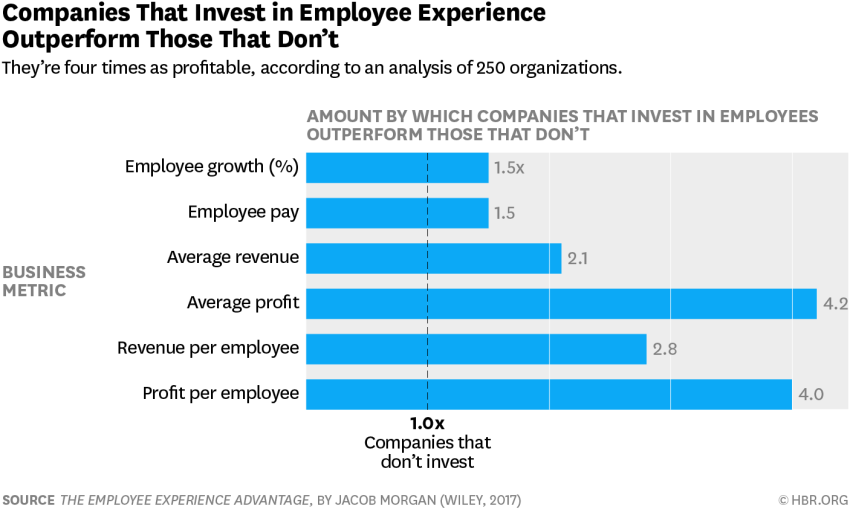
More engaged employees
When your workers feel happy in their environment, you will naturally see higher rates of employee engagement! From the employee perspective, if they work for a company that they know values them, then this will reflect in how much effort they put into their tasks.
An engaged workforce isn’t just one that knows how to get through their workload; it is also one that is aware of company matters. A lot more gets discussed in a business than just what everyone is doing. You have the overarching performance of the teams and the company as a whole. You might have industry changes to discuss, and, of course, there is always going to be water cooler chat!
Since employee experience directly affects how someone feels in a role, they are more likely to engage with a workplace that offers them a variety of opportunities to communicate. From posting a picture of their dog at the park at the weekend on a company chat to just being kept in the loop regarding big industry developments, an engaging workplace can look very different depending on who is interacting with it.
High quality of work
Obviously, those with exceptional employee experience will produce high quality work. Not only will their output be higher thanks to their engagement, but employees will also have everything they need to provide a consistent quality of work. Tools and support are in place so that even if they have never taken a task on before, an employee can approach their workload with confidence.
Employees may also be happier to take the initiative and go above and beyond to deliver more than expected to make the task the best it can be. As a result, you may see boosted collaboration. They choose to do this not because it is expected of them, but simply because they are engaged with the company and they actively want to perform well.
Happier clients
Happy employees who are engaged and able to complete their tasks to a high standard will obviously translate into satisfied clients and customers. Deadlines will be met easily, communication will be easy and open, and clients will be happy to return for repeat business.
Customer satisfaction is something that every company strives for since it is an important metric for measuring business performance. Most businesses will focus on customer experience when trying to improve. However, by looking to the employees instead, you can embed positive working practices in your company culture that all then work to boost key performance indicators (KPIs) and deliver a great overall experience for customers.
How to improve your employee experience
To deliver a positive employee experience for workers, a business needs a strategy in place. By taking the steps to break down the employee journey and work out the areas in a company that are currently lacking, real and lasting positive change can be brought to an organization. Here’s how.
1. Keep the employee experience at the forefront
When trying to specifically improve employee experience, the employee experience itself needs to remain central at all times. It can be easy to get lost in the details and have trains of thought run away somewhere else, so focus needs to be repeatedly brought back to the employee experience framework you develop.
For example, let’s say that a company decides to upgrade all their employees’ workspaces. They decide to invest in new desks and chairs to improve physical well-being. Rather than listen to what employees need from the areas that they will be working in every day, those in charge of the project let themselves get distracted by conversations about budgets and the aesthetic of the office. Suddenly, the focus is no longer about designing engagement into your floor plan.
While both of those are very important parts of the project and need to be discussed, the original proposal had employee satisfaction and experience in mind. The conversation needs to be recentered so that employee experience can return to the forefront once more.
2. Focus on the employee life cycle and journey
A great place to begin rejuvenating employee experience is the employee lifecycle itself. Remember, people are going to have an opinion about a company before they even submit an application to a job role.
As part of the hiring process, a candidate might reach out to your current employees on LinkedIn and ask for their impression of the company, or they might head to company review sites to take a look at what current and past employees truly have to say about working there. New hires want to feel secure that they have made the right decision to come aboard, and if they are greeted with a sea of stressed-out and frustrated colleagues, they might think they have made a mistake.
Though focusing on every stage of the employee lifecycle might seem like a mammoth task at first, little changes across the board will begin to add up. At its most basic, the employee lifecycle can be broken down into three stages:
- Pre-employment
- Employment
- Post-employment
By focusing on what a worker might wish to see and how they might wish to be treated across these stages, a company should be able to build a strategy that kicks in from the moment a potential hire comes into contact with the employer brand, right through to when the company and worker part ways.
3. Find the right tools
The tools used by the company will always have a massive impact on how employees experience their workdays. This is even more important as workplaces become even more digital. An organization might not offer remote work, or even have multiple offices, but the right set of tools can help with employee engagement and communication.
For example, social intranet software can help centralize communications and knowledge sharing. Rather than providing three or four channels – and the opportunity for something to get lost as it is shared in the wrong place – there is one place where a document or a conversation belongs.
Companies also need to make sure that there is adequate professional development and training for these tools as well. There is no point in introducing a certain piece of software if no one in the office actually knows how to use it – all that is going to do is cause delays and issues as people try to work out how to use it most efficiently.
4. Listen and implement employee feedback
Since employee experience has to be dictated by the employees themselves, it only makes sense that improvements are made after rounds of employee feedback. Managers have to give workers a chance to consider any improvements and whether they are beneficial. Running trial periods can be a great way to test the viability of a policy before it becomes standard across the company.
Collect thoughts and opinions via employee experience surveys. These rounds of constructive feedback can be essential in giving managers an insight into what their teams really think. They don’t even have to be extensive; a couple of questions on the company intranet hub page can quickly pick up the answers needed. Make the employee surveys anonymous and give them a chance to answer in their own words in addition to ticking boxes – most employees will value the chance to offer their own suggestions rather than purely adhere to the options management brings together.
Once data has been gathered from these employee experience surveys, make sure that they are implemented where possible. Since employee experience affects so many other aspects of business performance, employers need to tailor things to their workers to see good results.
5. Uplift employee voices
Employee feedback should not be the only occasion that workers have to submit their thoughts and opinions. Even actions as simple as allowing free thought during annual performance reviews can make a world of difference, giving space and weight to what employees feel. Many HR leaders use employee performance reviews as a chance to deliver the company’s expectations to an employee, so it is only fair to offer team members the opportunity to voice how they feel, too.
Make sure the culture of sharing also extends beyond performance management practices. Ideally, a team member should feel safe sharing honest feedback no matter their level in the company. Fostering a psychologically safe work environment can take a lot of conscious effort, but it can have a massive effect on business success.
Employees who feel uplifted and able to contribute to conversations and decisions will become more confident and secure in their decisions. They will feel like valued members of the team and not just cogs in the corporate machine.
6. Empower leaders
A lot of employee experience management will focus on the teams themselves. However, we must not forget about empowering and supporting managers, too. They are the ones who shape so much of the employee lifecycle. From acting as hiring managers to guiding new employees through the onboarding experience and potentially mentoring them to leadership positions themselves, the right leader can make all the difference.
Business leaders also deserve an exceptional employee experience as they are employees, too. More often than not, they are the ones who need to source the tools being used to speed up processes, and they have to try to wrangle employee perceptions and thoughts for their own managers to interpret. They deserve to be heard and cared for just like everyone else.
7. Commit to a diverse workforce
A diverse work environment brings with it fresh perspectives and positive challenges. If we all thought and acted the same way, the world would be a very boring place. Committing to developing a diverse workforce allows the business as a whole to benefit.
Take a look at current employee data and then work to create a fair workplace where everyone has a voice, and people of all backgrounds feel like they can safely speak up and bring change. Research shows us that prospective employees want to find diverse work environments, with 76% of job seekers considering a company’s diversity to be an important factor when looking for a new job.
8. Reward well
Celebrate the moments that matter. Give an employee recognition when they do something well. You can tap into the psychology of gamification or have everyone list their goals and achievements – and not just as a performance management task, but because you want everyone to feel good about what they are achieving through their work.
Likewise, make sure that you explain why people are doing what they are doing. If people have a clearer understanding of how their role directly benefits the company, they will gain more satisfaction from their work.
Don’t just keep the rewards big; make sure that even meeting the most basic of employee needs properly can feed into a culture of rewards. For example, encourage employees to take their full vacation allowance throughout the year, and when they do take vacation, honor their time away from their desks by not contacting them.
While vacation time in and of itself should not be considered a reward – it is one of the expected benefits we all deserve from our places of work – adequate space and the time to actually enjoy their time off should be. Give the employee recognition for their hard work and allow them to build a healthy work-life balance that celebrates everything they do.
Revitalize your employee experience today
The power of a good employee experience can’t be denied. It can:
- increase employee retention rates
- give your company a competitive advantage over others in your industry, and
- even lead to better business outcomes!
What an employee experiences in your organization will shape their opinion of you long after you leave, and could potentially lead to recruitment recommendations, supply contracts, and more positive benefits coming your way thanks to former employees.
Though their experience might technically start in the very first stage of the employee lifecycle, there are still plenty of improvements that can shape how long-term employees perceive the business.
A company intranet like Axero keeps communication centralized and provides one platform to organize documents and other important messaging. Don’t think it is all business; it can also be a place for fun! It is somewhere where employees can chat, exchange ideas, and even run surveys and polls. Create one space for communication within your company, and create a uniform employee experience that boosts everyone’s engagement and well-being.


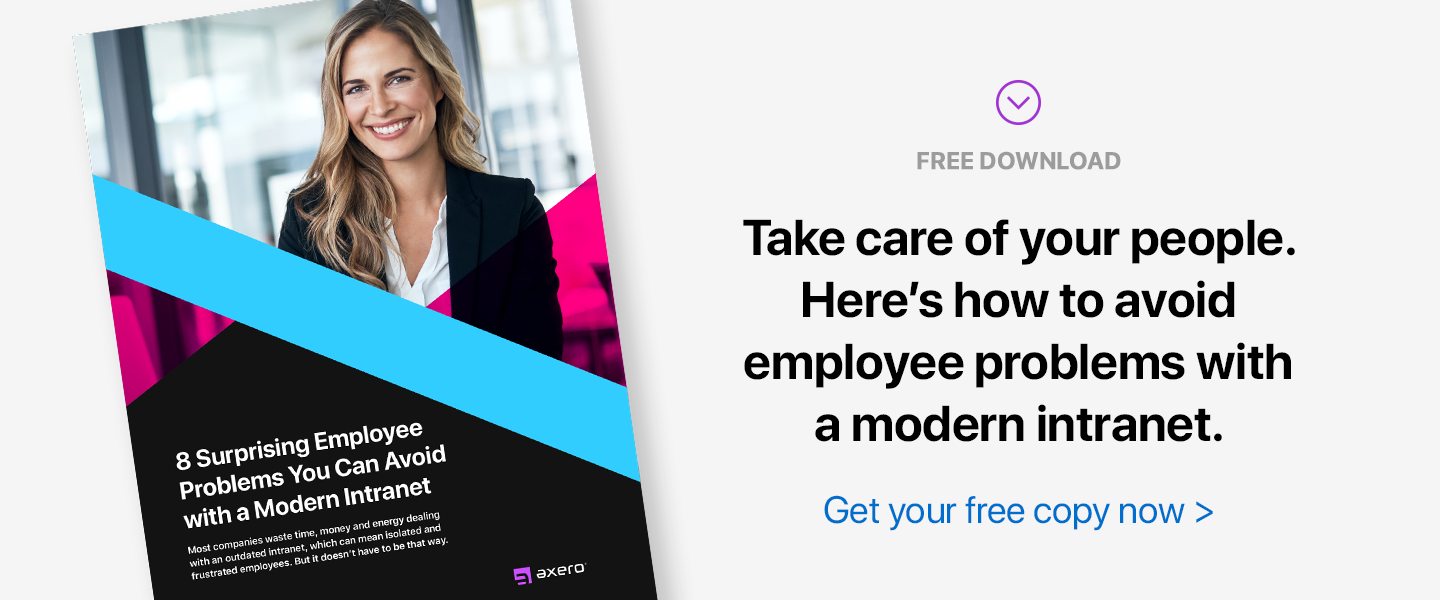

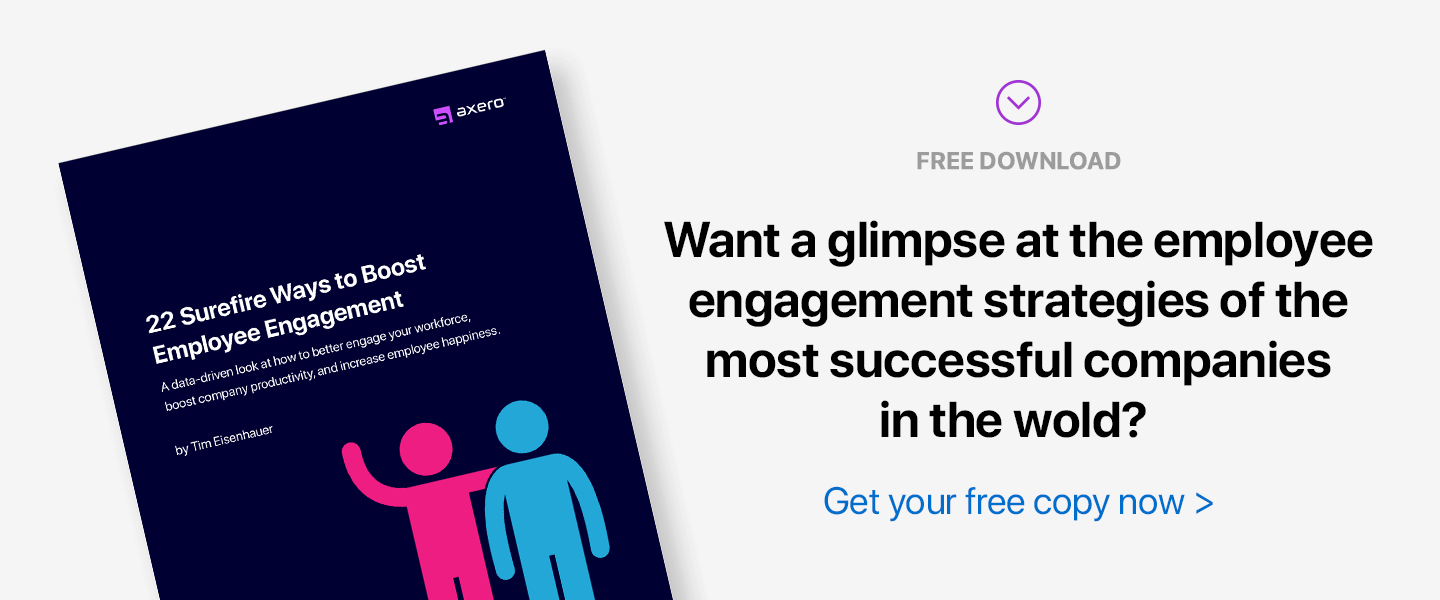
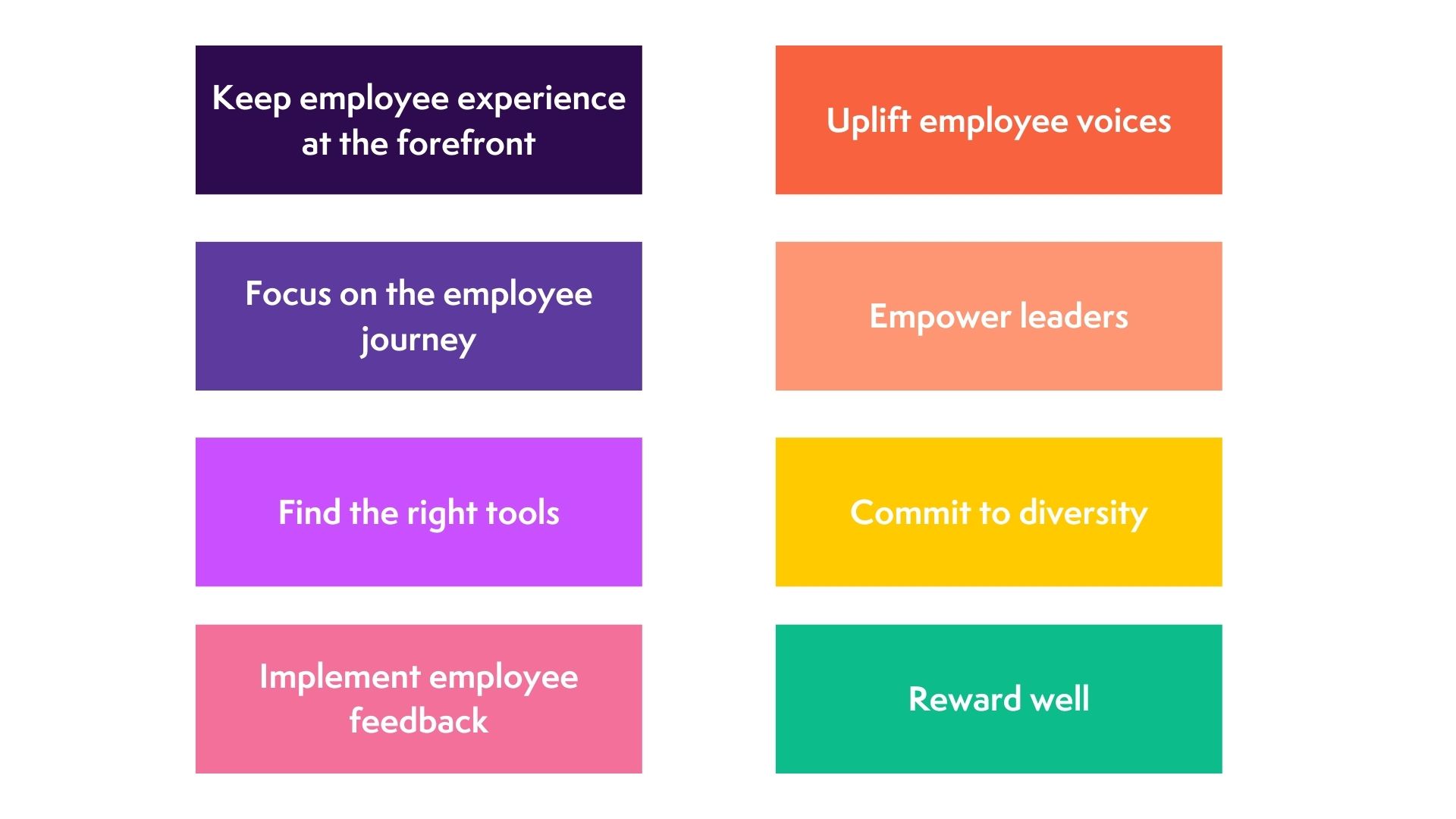

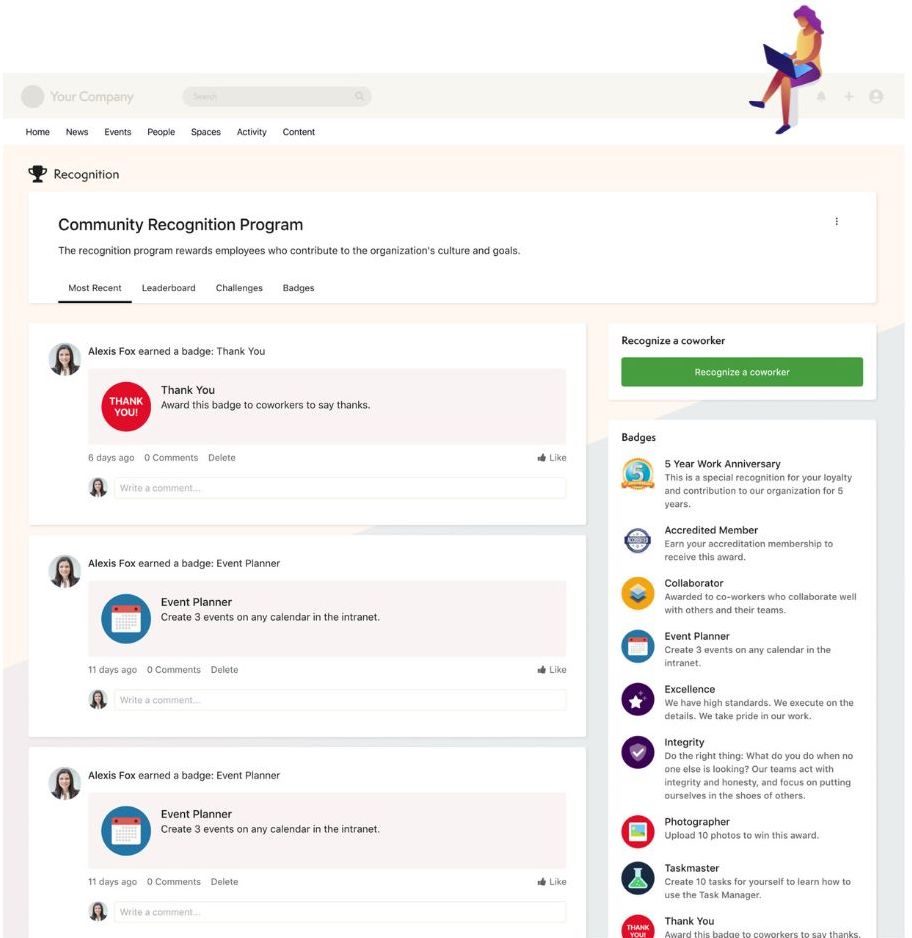
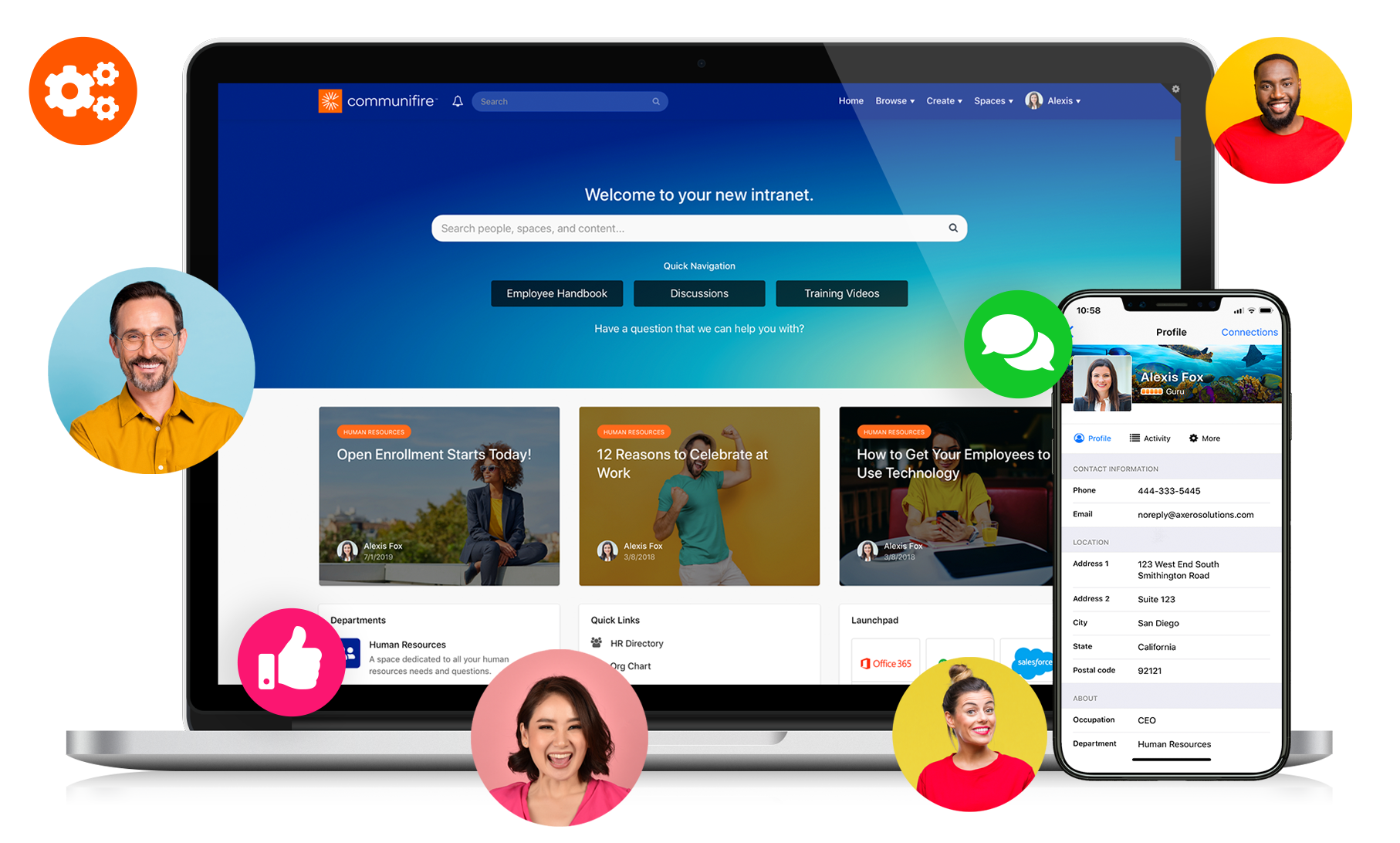











 info@axerosolutions.com
info@axerosolutions.com 1-855-AXERO-55
1-855-AXERO-55


